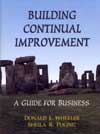|
 |
Building Continual Improvement
A guide for business
Donald J. Wheeler
Sheila R. Poling |
Chapter Two Visualize Your Process
2.1 Brainstorming
2.2 Flowcharts
2.3 Constructing Flowcharts
2.4 Deployment Flowcharts
2.5 PERT Diagrams
2.5 Do People Really Do This Stuff?
2.6 Processes and Systems
2.7 Cause-and-Effect Diagrams
Chapter Three Visualize Your Data
3.1 Running Records
3.2 Bar Charts
3.3 Pareto Charts
3.4 Histograms and Stem-and-Leaf Plots
3.5 Summary of Bar Charts and Running Records
3.6 Pie Charts
Chapter Four Graphical Purgatory
4.1 Computer-Generated Bar Charts
4.2 Computer-Generated Running Records
4.3 Stacked Bars and Linear Pie Charts
4.4 Radar Plots
4.5 Improving the Two Best Computer Graphs of Table 4.1
4.6 Summary
Chapter Five Some Arithmetic
5.1 Measures of Location
5.2 Measures of Dispersion
5.3 Ratios, Percentages, and Proportions
5.4 How Many Digits Do You Need?
5.5 Comparing Apples and Orange
- Part Two: Follow the Signals; Avoid the Noise
Chapter Six Visualize Your Process Behavior
6.1 Two Types of Variation
6.2 Two Types of Action
6.3 The Basic Process Behavior Chart: the XmR Chart
6.4 An XmR Chart for Accounts Receivable
6.5 What Do Predictable Processes Look Like?
6.6 Strong Signals and Weaker Signals
6.7 Why Johnnie Can't Breathe
6.8 Plans, Goals, Targets, and Process Behavior Charts
6.9 Exercises
Chapter Seven Using XmR Charts Effectively
7.1 Comparing Groups Using Process Behavior Charts
7.2 The "Has a Change Occurred?" Chart
7.3 Why Susie Can Breathe
7.4 What Kind of Data Belongs on an XmR Chart
7.5 Another Way to Compute Limits for the XmR Chart
7.6 Charting Profits and Losses
7.7 How Do You Use These Charts for Continual Improvement?
7.8 Exercises
Chapter Eight What Makes the XmR Chart Work?
8.1 The Logic Behind Process Behavior Charts
8.3 Why Three-Sigma Limits?
8.2 Where Does the Value of 2.66 Come From?
8.4 But How Can We Get Good Limits From Bad Data?
8.5 So Which Way Should You Compute Limits?
8.6 Chunky Data
8.7 Exercises
Chapter Nine Avoiding Man-Made Chaos
9.1 Creating Man-Made Chaos
9.2 Description Is Not Analysis
9.3 Charts for Each Region
9.4 So What If We Combined All Six Regions?
9.5 Avoiding Man-Made Chaos
9.6 Exercises
Chapter Ten Charts for Count Data
10.1 Counts and Measurements
10.2 Areas of Opportunity
10.3 Collecting Good Count Data
10.4 Charts for Counts
10.5 Charts for Rates Based on Counts
10.6 Some Cautions About Ratios Involving Counts
10.7 Summary
10.8 Exercises
Chapter Eleven Traditional Charts for Count Data
11.1 Charts for Binomial Counts: the up-Chart
11.2 Charts for Binomial Proportions: thep-Chart
11.3 Charts for Poisson Counts: the c-Chart
11.4 Charts for Poisson Rates: then-Chart
11.5 So How Should You Chart Count Data?
11.6 XmR Charts for Chunky Ratios
11.7 Process Behavior Charts for Rare Events
11.8 Summary
Chapter Twelve Average and Range Charts
12.1 Shewhart's Average and Range Charts
12.2 What Average Charts Do Best
12.3 When Does It Make Sense to Use Subgroups?
12.4 Daily Department Store Sales
12.5 Regional Sales by Quarter
12.6 More on Peak Flow Rates
12.7 Administrative Average and Range Charts
12.8 Exercises
Chapter Thirteen Seasonal Data
13.1 Moving Averages
13.2 Year-to-Date Plots
13.3 The Problem of Seasonal Effects
13.4 Deseasonalized Values
13.5 Finding Seasonal Factors
13.6 Not All Data Show Strong Seasonality
13.7 The Appliance Store Data
13.8 The Claims Per Day Data
13.9 Working with Seasonal Data
13.10 Exercises
- Part Three: Building Continual Improvement
Chapter Fourteen Collecting Good Data
14.1 What Are You Trying to Do?
14.2 Operational Definitions
14.3 Counts and Categories
14.4 The Problems of Aggregation
14.5 Ratios of Aggregated Measures
Chapter Fifteen The Learning Way
15.1 Mail Order Improvement
15.2 Plan, Do, Study, Act
15.3 "Let's Reduce Losses on Beer and Sake Sales"
15.4 What Should You Do Now?
SPS Press, Inc. 1998г
